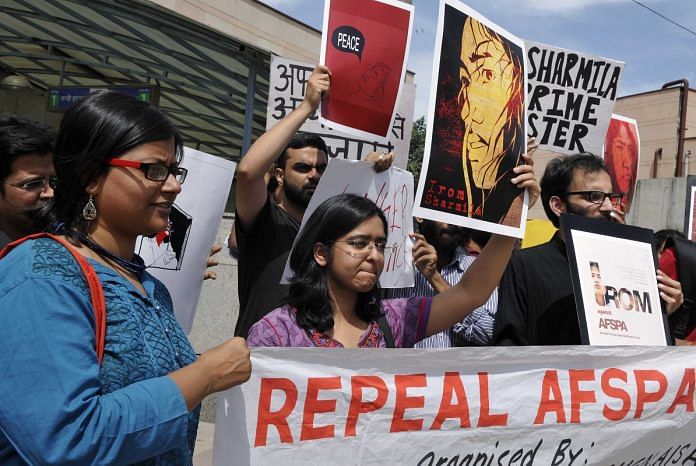AFSPA has been controversial ever since it was first deployed in ‘disturbed areas’, given the extraordinary powers it granted to armed forces personnel.
New Delhi: The Centre withdrew the controversial Armed Forces (Special Powers) Act from Meghalaya and parts of Arunachal Pradesh Monday, citing a drastic reduction in insurgency.
Both states had been under AFSPA for almost 25 years, and had witnessed much public resistance to the act, which has often been described as ‘draconian’ in terms of the amount of power it gives to the security forces.
What is AFSPA?
AFSPA is a law that gives extraordinary powers to the armed forces in ‘disturbed areas’.
It has been in force in Assam, Nagaland, Manipur, and Jammu and Kashmir for decades. It was repealed from Punjab and Chandigarh in 1997, and from Tripura in 2015.
It came into force as the Armed Forces Special Powers Ordinance of 1942, when the British government wanted to quell the Quit India Movement.
The act is meant to enhance the efficiency of the armed forces in hostile areas and gives them powers, including:
– The authority to arrest people or enter and search their premises without a warrant.
– Prohibit a gathering of five or more people.
– Open fire or use force even if it results in death, after giving due warning.
The act also gave army officers legal immunity for their actions, but after widespread criticism, this provision was done away with by a landmark Supreme Court judgment in July 2016.
AFSPA in the northeast
In the face of the mounting threat of secessionist movements, the Centre decided to implement AFSPA in the northeast in 1958. At the time, it was meant to be only for a year, but has continued.
Initially, the act was enforced only in the Naga Hills and parts of Assam. However, in the following decades, it gradually spread to the other ‘Seven Sisters’.
Controversies triggered by AFSPA
Despite accusations of rape, murder, and destruction of property, not a single officer in these ‘disturbed areas’ is reported to have faced prosecution until the middle of 2016.
For instance, Thangjam Manorama, a resident of Manipur, was allegedly raped, tortured and killed by armed forces personnel in 2004, sparking widespread protests in the state. But no one was prosecuted.
Similarly, in the 1960s, armed forces personnel were accused of burning villages in Nagaland and Mizoram, under the protection of AFSPA. Officers allegedly forced villagers to leave their homes at gunpoint, after which they were herded together with strangers and forced to form new villages. But no investigation was reportedly carried out.
Movements against AFSPA
The powers and functioning of the forces have sparked protests from time to time.
Thirty middle-aged women protested Thangjam Manorama’s rape and murder by walking naked through the streets of Imphal, to the Assam Rifles headquarters.
They shouted slogans and carried posters saying “Indian Army, rape us too… We are all Manorama’s mothers”.
The 2012 Justice Varma Committee report, which suggested many measures to reduce violence against women, was influenced in part by these protests.
Irom Sharmila’s marathon fast
Irom Sharmila went on a hunger strike in 2000 for 16 years, to protest the Malom Massacre, when 10 civilians, including a 62-year-old woman, were killed in an episode of indiscriminate firing.
Sharmila was arrested time and again and charged with attempted suicide, but her protest gathered increasing support in the mainstream Indian and international media.
Sharmila finally ended her hunger strike in June 2016 and decided to enter politics in order to continue her fight.
Government’s stand
Despite the criticism of the act, the government and the Army have stuck to the argument that the removal of AFSPA from conflict areas will give a free hand to insurgents to capture the area and cause further unrest.
For instance, in 2017, the government asked the Supreme Court to reconsider its landmark decision that restrained the Army from using “excessive or retaliatory force”. It claimed that the verdict was hampering the Army’s ability to respond to insurgency-related situations.






